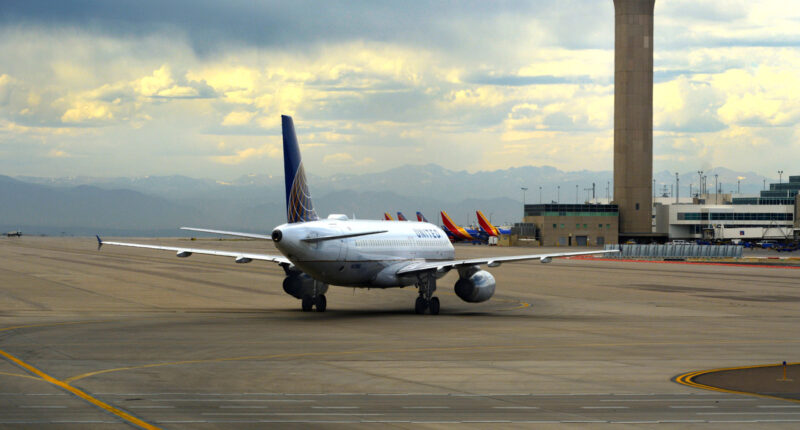Another significant airport experienced a communication breakdown, leading to pilots being unable to communicate with air traffic controllers for as long as six minutes.
The technical glitch at Denver International Airport follows two communication meltdowns at Newark International Airport in the past two weeks.



Approximately 20 pilots en route to Denver airport faced issues reaching air traffic controllers on Monday, according to reports from Denver’s ABC affiliate KMGH.
Sources indicated that the incident occurred around 2 pm, causing “between 15 and 20 aircraft to lose communication with air traffic control at a crucial moment.”
The communication failure was due to multiple radio transmitter outages while they were descending, according to the sources.
The FAA confirmed the outage at the airport but insisted it lasted 90 seconds as two transmitters went down.
Disaster was averted as a controller was able to contact one pilot on a “guard line” – essentially an emergency channel.
This system is normally used when a pilot is in distress.
The workaround enabled the pilot to then contact other landing aircraft to change frequencies.
Four frequencies from the two main towers at the Denver Air Route Traffic Control Center in Longmont, about 30 miles northwest of the airport, were already out of service when the technical glitch occurred, sources told KMGH.
This exacerbated the tense situation as air traffic controllers had been communicating with approaching pilots on their backup fifth frequency, which then also broke.
The critical control center usually ensures planes have enough space as they start to land.
The Longmont control center encompasses approximately 285,000 square miles of airspace over portions of nine states: Arizona, Colorado, Kansas, Montana, Nebraska, New Mexico, South Dakota, Utah, and Wyoming, according to the Federal Aviation Administration.
Sources said failing old equipment was to blame for the blunder.
That meant traffic control was whittled down to its last frequency to use when communicating directly with pilots.
“When you’re down to the last available redundancy, what happens next, when that goes out?” asked David Riley, retired air traffic controller.
Denver still had radar coverage, but that’s like watching a car crash happen and not be able to do anything about it.
“The scariest part is that it’s not unique to this situation, these kinds of outages happen around the country all the time.”
Riley, the former head of the local air traffic controllers union, also said, “It’s one thing to lose track of one airplane because you can’t communicate with them.
“But to lose track of all of the airplanes that you had communication with?
“And from my understanding, in this situation, they still had radar coverage, but that’s like watching a car crash happen and not be able to do anything about it.
Recent ‘cluster’ of plane crashes

A NUMBER of recent plane crashes in the US have left Americans terrified of traveling by air.
However, aviation expert and attorney Jason Matzus told The U.S. Sun the crashes can be attributed to “random clustering.”
“While these events are tragic, the likely explanation is simply ‘random clustering,’ which occurs when multiple crashes occur over a short period, warping our general perception and causing us to think that there is an increasing trend in plane crashes,” Matzus said.
“When in reality these crashes, despite being so close together, are merely coincidental and not caused by a systemic safety issue.”
The short period Matzus is referring to is just a matter of three weeks. The recent aviation mishaps include:
January 29 – A military helicopter and American Airlines plane collided at the Washington DC airport and killed 67 people
January 31 – An air ambulance carrying a six-year-old girl and her mom crashed onto a street in Philadelphia, killing seven people in total
February 5 – A Japan Airlines flight hit a parked Delta plane at Seattle SeaTac Airport and no one was injured
February 6 – A small commuter plane on its way to Nome, Alaska, crashed and killed all 10 people on board
February 10 – Motley Crue singer Vince Neil’s private jet collided into another plane, killing the pilot and injuring four others
February 17 – A Delta plane crashed onto the runway at Toronto Pearson International Airport, miraculously killing no one but injuring 21
February 19 – Two planes collided at Marana Airport in Arizona, killing two people
March 13 – American Airlines passengers were forced to escape a burning plane by climbing onto the wing at Denver – there weren’t any serious injuries reported
“It’s not acceptable, and the biggest problem is the fact that the FAA does not have stable funding to replace this equipment and maintain it in an appropriate fashion.”
KMGH said it learned the main transmitter has been “out for at least three days.”
FAA RESPONDS
The U.S. Sun contacted Denver airport and the FAA for comment.
A spokesperson for the airport deferred to the FAA.
“Part of the Denver Air Route Traffic Control Center (ARTCC) experienced a loss of communications for approximately 90 seconds around 1:50 pm local time on Monday, May 12, when both transmitters that cover a segment of airspace went down,” the FAA told The U.S. Sun.
“Controllers used another frequency to relay instructions to pilots.
“Aircraft remained safely separated and there were no impacts to operations. The FAA is investigating.”
The incident comes two months after American Airlines passengers at Denver International were forced to escape a burning plane by climbing onto the wing.


SERIES OF OUTAGES
The communication problem in Denver also follows two outages at Newark airport in New Jersey, including one lasting for 90 seconds.
Air traffic controllers directing planes into Newark briefly lost their radar on the morning of May 9 for the second time in two weeks.
FAA bosses said the radar at its facility in Philadelphia, which directs planes in and out of Newark, went black for 90 seconds at 3:55 am.
A similar outage occurred on April 28.
The initial radar outage led to hundreds of flights being canceled or delayed at Newark.
Five controllers went on trauma leave, worsening the existing shortage, as a result of the horrific situation they faced.
PASSENGER SAFETY
Such incidents are raising concerns about passenger safety.
Especially as radio contact with pilots is failing nearly every week, terrified air traffic controllers have warned.
Aviation expert William McGee told NPR on Sunday that the FAA “is an agency that has been understaffed and underfunded for four decades.”
“Newark Liberty International Airport is sort of the poster child for everything that’s wrong with air traffic control,” he said.
“In the United States, we have the most complex and largest air traffic control network in the world, and we lag dozens… of other nations in terms of the number of controllers and in terms of the infrastructure and the technology.”
NEW SYSTEM
On Tuesday, the FAA said in a statement about Newark.
“There is a nationwide shortage of air traffic controllers, and the FAA for years has not met the staffing goal for the area that works Newark airspace,” the FAA said.
“Transportation Secretary Sean P. Duffy has made air traffic controller hiring a top priority.”
Duffy this month promised that the Department of Transportation would build a “brand new air traffic control system” by 2028.
More than 4,600 new high-speed connections are to be installed, while 618 radars will be replaced across the country.
Officials developed the ambitious overhaul after a deadly midair collision in January between a passenger jet and an Army helicopter killed 67 people in the skies over Washington DC.

















